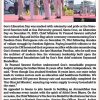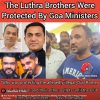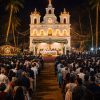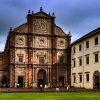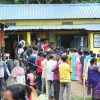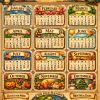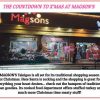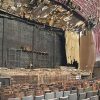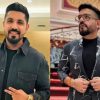Goa is abuzz with excitement as vintage bike and car owners, users, collectors and fans are decking […]
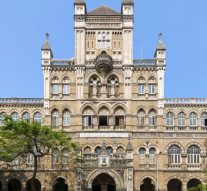
LOSS OF INNOCENCE, LOOKING BACK AT 70’S BOMBAY
MEMOIRS September 20, 2025By Rajan Narayan
BOMBAY, now Mumbai, was the home of idealism in the 70s. It was a time when the brightest and the best, including the bold and the beautiful and the rich and the powerful, became part of the left movement. The Xavier’s and Elphinstone colleges were the cradles of protests against the ruling elite. The generation X of the 70s believed that they could change the world. They believed in social justice. They not only sympathized but empathized with all the marginalized sections of society from labor working class to Dalits.
The daughter of the chief public prosecutor of Bombay, Anuradha Shanbag, daughter of Ganesh Shanbag, got radicalized when she was a student of the Ephinstone College. Anuradha, after completing her Masters in Sociology got married to Kobard Gandhi, who was one of the leaders of the left movement. Kobard’s family ran a premium ice-cream mini-factory at Worli. Whenever batches of ice-cream did not measure up to the high standards desirable there would be an ice-cream party at Kobard’s residence.
Here at Kobard’s residence all the passionate young women and men met to express their deep commitment to the leftist movement ovr an ice-cream treat. Both Kobard and Anuradha took to the jungles of Nagpur to join the Naxals in liberating the tribals from the oppression of the upper castes and also ruthless businessmen. The gun Anuradha carried was bigger than her petite five-feet frame. But sadly one day Anuradha died in the forest, not in an encounter but of falcipuram malaria. Kobard, who was a member of the politbureau of the Marxist Leninist (ML), was “captured” and he spent over a decade in jail. The UK-trained chartered accountant was finally released and he continues to live in his ancestral home in Worli, Mumbai.
RADHA Iyer was the daughter of the managing director of American Express in India based in Mumbai. Radha gave up the good life of an upper middle class, happy-go-lucky young woman. She gave up chiffons sarees, denim jeans and Dior handbags. I remember Radha coming to me and asking for my help in finding a shop floor job at the NELCO factory. NELCO, ironically, was the first factory managed by the late Ratan Tata. It predominantly employed women in the assembly of transistors, radios and black and white television sets.
Radha shed her fancy attire and bought herself several pairs of cheap salwar-kameez, she played a major part in unionizing the workers of NELCO. She carried her Marxist principles to theological corollary and fell in love and married Freddy Dias, the leader of the union of the German Siemens plant in Worli. Freddy was murdered by goons of the Datta Samant union which wanted to displace Freddy. Radha, who had two daughters with Freddy, switched to a law career and continued to be loyal to the faith.
Then there was Vasanti Raman who was doing her PhD at Bombay University. Vasanti came under the influence of the leading Marxist ideologue, Prof Devanathan, of the Bombay School of Economics. The very elegant and stylish Vasanti also declassed herself. She was very active in educating women and young students in the ways of the left movement. Vasanti, along with Devanathan, were arrested during the Emergency declared by then Prime Minister Indira Gandhi in 1975. Vasanti was kept in prison with hardened criminals and victims of leprosy. They could not break her spirit and she emerged from prison stronger than ever.
ANAND MOHAN SAHAY was a colleague in The Financial Express, the financial daily of the Indian Express group. This was way back in the early 70s, when as a 21-year-old I had joined the Express group as a trainee journalist. Sahay belonged to the Trotsky group of Marxists. Leon Trotsky was one of the original leaders of Marxist Soviet Union. Trotsky was murdered by Stalin who converted the then Soviet Union into the so called dictatorship of the proletariat. Unlike Lenin and Marx, the Trotskyites believed in permanent revolution.
Sahay quit the Financial Express to become a full-time activist. Being from Bihar, Sahay never managed to become part of the elite group of Marxists who then dominated the movement. Sahay’s problems were compounded by the fact that he was compelled by the family to have an arranged marriage. His wife Kumud was a simple village girl who could not understand Sahay’s hi fi ideas of liberating the working class. But Sahay was a genuine emotional Marxist. He was the first person to give me shelter in his house in Andheri when my father suddenly abandoned the family and I had to care for my mother and sister.
Interestingly, it was Sahay who first introduced me to Achin Vinaik and Anand Grover during the Emergency. We met at an Aunty’s Bar in the Fort area close to the offices of The Free Press Journal where I was working. Both Achin and Anand Grover had come to India from the UK to join the fight against the Emergency. Achin went on to become a senior assistant editor at The Times of India. He was also one of the leaders of the TOI union and later fellow journalist Pamela Philipose. Anand Grover, who had a law degree from Oxford, married Indira Jaisingh.
THEN of course there was the Marxist-influenced Bombay University of which Praful Bidwai was the self-styled vice-chancellor. The parallel university used to conduct regular study classes for the young students of the elite colleges of Bombay, particularly the Elphinstone and Xaviar’s colleges. Attendance was compulsory and absenteeism was frowned upon. I recall a young women from Xaviar’s who was not able to attend a few classes. When she re-surfaced Praful Bidwai asked her why she did not attend classes? The young woman muttered something about attending a marriage in the family. The sharp rebuke was: Where is your class conscience? Comrades were not supposed to take time off for frivolous bourgeois events like marriages and birthdays.
It is not widely known that the Christian church was greatly influenced by Marx, particularly in Latin America. Amongst the classics of Marx literature is the pedagogy of the oppressed by the Jesuit priest Franz Fannon. This inspired Bombay-based Protestant Bishop George Ninan. Ninan apaproached me through his nephew, Varkey Mathew, an old friend of mine from Bangalore, who was working for the City Bank in Bombay. I introduced Ninan to left activists like Radha Iyer and Anand Mohan Sahay. They all took part in the struggle of the slum works of the Janata Colony in Chembur who were fighting against eviction threats.
The left movement came home in the form of Sagar Dhara, an IIT dropout active in the trade union movement. My sister Lalitha happened to fall in love with Sagar and later married him. Though Sagar wore torn jeans and kurta he was actually the son of a very rich tobacco farmer from Andhra Pradesh. My mother was very opposed to my sister’s relationship with Sagar as she saw him as a “jobless useless” character. She of course changed her mind when she learned about his family background. Sagar was responsible for the closure of the Leela Lace factory of Captain Krishnan Nair in Andheri. Maybe he did Capt Nair a favor because it proded him to set up the Leela Hotel near the international Sahar Airport.
I WAS part of the left but I did not join any of the groups which were constantly at war with each other. There were many groups with their own interpretation of the legacy of Karl Marx. Many fellow travelers were upset over Stalin converting the Soviet Union into a dictatorship. Mao and Ho Chi Min who liberated Vietnam were the true heroes of the left movement in Mumbai. I was the flavor of the left movement because I was a journalist. I had access to free tickets for Hindustani and Western music concerts, also English plays. Though the elite young women who joined the left were willing to give up chiffon sarees and Gucci clutches they loved their cultural interests. So they were all happy to come with me for concerts and plays. In fact, the Rang Bhavan next to Xavier’s College was full of jhola-carrying left comrades taking appreciating the concerts of Pandit Ravi Shankar and Ustad Alla Rakha. Part of the attraction of the left movement was here were the prettiest girls and dating them was not too heavy in the pockets for they were very comfortable in an Irani chai shop discussing the nuances of Marxist ideology.
